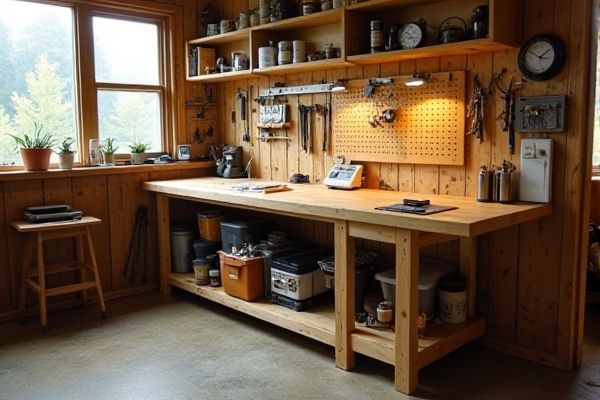
A fold-down workbench offers space-saving flexibility by folding against the wall when not in use, making it ideal for small workshops or garages, while a stationary workbench provides a sturdy, permanent surface suited for heavy-duty tasks and long-term projects. Explore the rest of the article to discover which workbench best fits your workspace and project needs.
Table of Comparison
| Feature | Fold-Down Workbench | Stationary Workbench |
|---|---|---|
| Space Efficiency | High - Folds flat against the wall to save space | Low - Fixed, requires dedicated floor space |
| Portability | Moderate - Can be folded and repositioned | Low - Heavy and fixed in one location |
| Stability | Moderate - Depends on wall mounting and design | High - Solid construction with heavy materials |
| Weight Capacity | Moderate - Suitable for light to medium tasks | High - Supports heavy-duty tasks and tools |
| Installation | Requires secure wall mounting | Simple - Usually ready to use |
| Use Case | Ideal for small workshops and multi-use rooms | Best for dedicated workshops and heavy projects |
Introduction to Fold-Down and Stationary Workbenches
Fold-down workbenches save valuable space by folding against the wall when not in use, ideal for small workshops or garages. Stationary workbenches offer a sturdy, permanent surface with enhanced stability, perfect for heavy-duty tasks and continuous projects. Choosing between them depends on your space availability and the type of work you perform.
Space Efficiency: Fold-Down vs Stationary Workbenches
Fold-down workbenches maximize space efficiency by collapsing against the wall when not in use, making them ideal for small workshops or garages with limited floor area. Stationary workbenches offer a sturdy, permanent workspace but occupy more room, reducing available floor space for other tasks. Choosing a fold-down workbench allows you to optimize your workspace without sacrificing functionality.
Flexibility and Mobility Comparison
Fold-down workbenches offer exceptional flexibility and mobility by allowing users to save space through wall-mounted designs that can be folded away when not in use, making them ideal for small workshops or garages. Stationary workbenches provide superior stability and support for heavy-duty tasks but lack portability, making them best suited for permanent workstations in dedicated workshop areas. Choosing between the two depends on whether prioritizing space-saving convenience or robust, fixed workspace is more important for the user's needs.
Installation and Setup Differences
Fold-down workbenches require wall mounting with sturdy anchors to ensure stability, making their installation more space-conscious and suitable for smaller areas. Stationary workbenches demand a solid, level floor space and often involve heavier assembly with bolts for maximum durability and load capacity. Your choice depends on whether you prefer quick, space-saving setup or a permanent, robust workspace.
Durability and Longevity of Workbenches
Fold-down workbenches often feature durable materials like steel brackets and hardwood surfaces designed to withstand regular folding and unfolding, ensuring long-lasting functionality in compact spaces. Stationary workbenches boast robust construction with heavy-duty frames and thick tops that provide exceptional stability and endurance for intensive, prolonged use. Both types prioritize longevity, but stationary models typically excel in heavy-load resilience and wear resistance due to their fixed, solid build.
Cost Analysis: Fold-Down vs Stationary Workbenches
Fold-down workbenches typically offer cost savings due to their compact, space-saving design and simpler materials, making them ideal for small workshops or garages. Stationary workbenches, while generally more expensive upfront, provide greater durability and stability, which can reduce long-term replacement and repair costs. Your choice between fold-down and stationary workbenches should consider not only initial price but also the value of space efficiency versus heavy-duty function.
Ideal Use Cases and Applications
Fold-down workbenches are ideal for small spaces where you need a versatile, temporary workspace that can be easily stored when not in use, making them perfect for garages or workshops with limited floor area. Stationary workbenches provide a robust, permanent surface suited for heavy-duty tasks, large-scale projects, and environments requiring stability and durability, such as professional workshops or manufacturing settings. Selecting the right option depends on your available space and the intensity of your work needs.
Safety Considerations in Both Workbench Types
Safety considerations for a fold-down workbench include secure mounting to wall studs and reliable locking mechanisms to prevent accidental collapse during use. Stationary workbenches offer inherent stability due to their fixed legs and solid construction, reducing the risk of tipping or movement under heavy loads. Your choice should factor in workspace constraints and the specific safety needs of your projects to ensure a secure working environment.
Maintenance and Upkeep Requirements
Fold-down workbenches require minimal maintenance due to their compact design and fewer moving parts, reducing dust accumulation and wear over time. Stationary workbenches, while offering robust support, often demand regular upkeep such as tightening bolts, cleaning large surfaces, and occasional refinishing to maintain durability. Choosing your workbench should factor in how much time you're willing to invest in maintenance to ensure long-term functionality.
Choosing the Right Workbench for Your Workspace
Fold-down workbenches maximize space efficiency by offering a compact design that can be easily stowed when not in use, ideal for small or multifunctional work areas. Stationary workbenches provide robust stability and larger surface areas, making them well-suited for heavy-duty tasks and permanent workshop setups. Evaluating workspace size, usage frequency, and tool requirements helps determine whether a fold-down or stationary workbench best supports productivity and organization.
 homyna.com
homyna.com